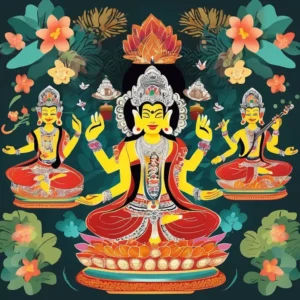The gentle morning mist rolls across the emerald rice terraces of Ubud as the first rays of sunlight pierce through the tropical canopy. In a nearby temple, a Hindu priest begins his daily ritual, his voice carrying ancient Sanskrit syllables that have echoed through these valleys for centuries. These are the sacred mantras of Bali, powerful sound formulas that serve as bridges between the physical and spiritual worlds, connecting practitioners to the divine through vibration and intention.
The Origins and Significance of Balinese Mantras
Balinese mantras represent a unique fusion of Hindu and indigenous traditions, reflecting the island’s rich spiritual heritage. While many of these sacred sounds originated in ancient India, they have been woven into the fabric of Balinese culture, acquiring distinct local characteristics and meanings over the centuries. The word „mantra“ itself comes from two Sanskrit roots: „man“ (mind) and „tra“ (tool or instrument), literally meaning „an instrument of thought.“
In Balinese spiritual practice, mantras are more than mere words or sounds. They are considered living energy, vibrations that can transform consciousness and connect the practitioner to specific aspects of the divine. Each mantra is believed to contain shakti (divine energy) that, when properly intoned, can produce specific effects ranging from healing and protection to spiritual awakening and material abundance.
The Role of Mantras in Balinese Daily Life
Unlike many other spiritual traditions where mantras are reserved for special ceremonies or initiated practitioners, Balinese mantras are deeply integrated into daily life. From farmers blessing their fields to merchants opening their shops, from healers treating patients to mothers protecting their children, mantras provide a sacred soundtrack to the rhythm of Balinese life.
A typical day in Bali might begin with the soft murmur of the Gayatri Mantra, considered one of the most powerful and universal of all Hindu mantras. As the sun rises, many Balinese will recite:
„Om Bhur Buvah Svah Tat Savitur Varenyam Bhargo Devasya Dhimahi Dhiyo Yo Nah Pracodayat“
This ancient prayer to the sun deity is believed to illuminate the intellect and dispel ignorance, setting a positive tone for the day ahead.
Common Balinese Mantras and Their Applications
Healing Mantras
Among the most frequently used mantras in Balinese healing traditions is the Om Namah Shivaya. This five-syllable mantra is considered particularly powerful for physical and emotional healing, as it invokes Shiva in his aspect as the supreme healer. Balinese healers, known as balians, often combine this mantra with traditional herbal remedies and energy work.
Another important healing mantra is the Mrtyunjaya Mantra, which is believed to overcome death and disease:
„Om Tryambakam Yajamahe Sugandhim Pushtivardhanam Urvarukamiva Bandhanan Mrityor Mukshiya Maamritat“
Protection Mantras
For protection against negative energies and harmful influences, many Balinese turn to the powerful Durga mantra:
„Om Dum Durgayai Namaha“
This mantra invokes the fierce protective energy of the goddess Durga, who is particularly revered in Bali for her ability to ward off evil and protect devotees from harm.
The Science Behind Sacred Sound
Modern science is beginning to understand what Balinese mystics have known for centuries: sound has the power to affect matter and consciousness. Research in the field of cymatics has shown that specific sound frequencies can create distinct geometric patterns in matter, while neurological studies have demonstrated the effect of mantric recitation on brain wave patterns.
When a mantra is chanted, several things happen simultaneously:
- The physical vibration of sound affects the body at a cellular level
- The rhythm and repetition help calm the nervous system
- The focused concentration required for proper recitation aids in meditation
- The specific frequencies generated may stimulate different areas of the brain
Learning and Practicing Balinese Mantras
While many Balinese mantras are freely shared, some are considered sacred and are only transmitted from teacher to student in specific ceremonial contexts. For those interested in learning Balinese mantras, it’s important to approach the practice with respect and proper guidance.
Key Principles for Mantra Practice
- Pronunciation: Correct pronunciation is crucial, as the power of mantras is believed to lie partly in their precise sound vibrations
- Timing: Many mantras are traditionally recited at specific times of day or during particular lunar phases
- Intention: The mental focus and spiritual intention behind the mantra are as important as the sound itself
- Repetition: Mantras are typically repeated a specific number of times, often using a mala (prayer beads) to keep count
The Role of Mantras in Balinese Ceremonies
Balinese ceremonies, known as odalan, are elaborate affairs where mantras play a central role. During these sacred events, priests and practitioners use specific combinations of mantras to consecrate offerings, purify spaces, and invoke divine presence. The air becomes thick with the sound of bells, drums, and sacred syllables as the boundary between the seen and unseen worlds grows thin.
One particularly moving ceremony is the Melukat, or water purification ritual, where mantras are chanted while blessed water is poured over participants to cleanse them of negative energies and restore spiritual balance.
Preserving Ancient Wisdom in Modern Times
As Bali faces the challenges of modernization and cultural change, efforts are being made to preserve and document its sacred mantra traditions. Many young Balinese are taking a renewed interest in their spiritual heritage, studying with traditional teachers and finding ways to integrate these ancient practices into contemporary life.
Several organizations are working to record and preserve the proper pronunciation and application of Balinese mantras, ensuring that this precious spiritual technology will be available for future generations. Some temples have begun offering workshops and classes to both locals and visitors, sharing these sacred sounds while maintaining appropriate cultural boundaries and respect for tradition.
Conclusion
The sacred mantras of Bali represent more than just an ancient spiritual practice; they are a living tradition that continues to evolve and adapt while maintaining its essential power and purpose. In a world increasingly dominated by noise and distraction, these sacred sounds offer a path to inner peace, healing, and connection with the divine.
Whether echoing through ancient temple corridors or whispered in morning meditation, Balinese mantras remind us of the profound power of sound to transform consciousness and connect us with something greater than ourselves. As we face the challenges of the modern world, perhaps these ancient vibrations carry wisdom we need now more than ever – the understanding that through sacred sound, we can tune our individual consciousness to the greater harmony of the universe.






